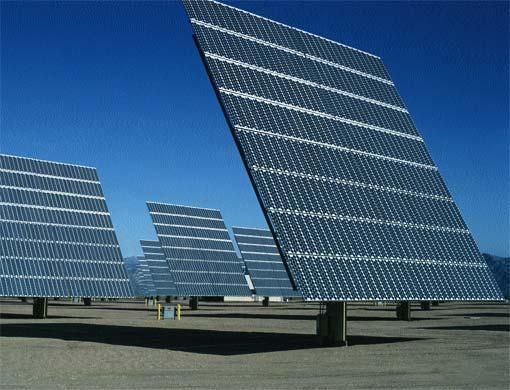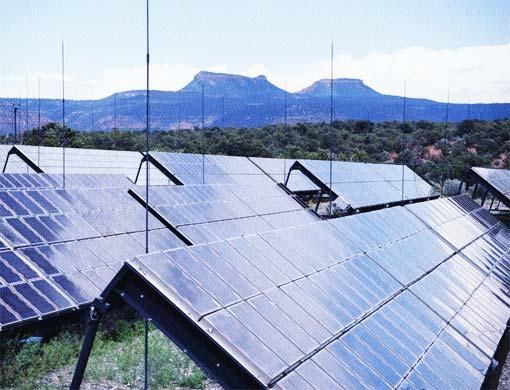Converting the sun's energy to power modern living has long-term ecological benefits, but there are stumbling blocks too. Suchitra Bajpai Chaudhary reports how Dubai is pushing for green with solar energy
Solar power had a different meaning during my summer holidays.
It used to be defined by piquant aromas of dried pickles and spices; and freshly-rolled out poppadums that would bask in the sun as languorously as the raw mangoes and mint leaves.
It was also defined by the sunning of carefully laid out mattresses and rugs, and the airing of woollens that would flutter in a carefree manner with the warm summer breeze.
The sun used to be celebrated through these simple acts of domesticity.
Today its powers are no longer confined to the hearth, but have become a study for renewable energy resources for sustainable development.
Solar energy has been identified as the most powerful source of renewable energy apart from thermal, wind, wave and nuclear. And as we grapple with ecological conservation issues, solar energy is being addressed in ways like never before.
The sheer magnitude and vastness of the sun's power is difficult to grasp. Each year the total solar energy intercepted by the earth is about 5.5 million exajoules.
If we could harness even one per cent at a mere five per cent efficiency, we would then have enough energy for the earth's inhabitants for the next several billion years!
Imagine if your washing machine, dishwasher, computer, air-conditioning and car worked on solar energy ... This would translate into zero pollution and a massive shrinkage in your eco-footprint.
Many countries are switching to solar energy. However, if it were easy to switch, every country would have done so. Observably, there are many stumbling blocks, the major one being capital cost.
Understanding solar energy
Let us understand how the energy of the sun is converted into electricity to power modern living.
Prabissh Thomas, managing director of Green Energy LLC, one of the largest Middle East solution providers of solar and renewable energy products marketed under the brand name GE Solar, explains the process in simple terms.
"One of the more amenable ways of converting solar energy to electricity is through PV (photovoltaic) cells. The PV system consists of wafers made of silicon or other conductive materials.
"When sunlight hits the wafers, a chemical reaction occurs, resulting in the release of electricity. Power thus generated is stored in batteries. Our appliances run on Alternating Current (AC), whereas power generated is Direct Current (DC).
"A simple inverter enables the DC to be converted to AC for domestic use. The amount of power you require will be determined by the size of the equipment to be used and that in turn will determine the size of your photovoltaic cell."
While GE Solar has been instrumental in solar powering many commercial projects in the UAE, most of their successful projects have been in African countries where widespread use of solar power is prevalent in all sectors. It has representative offices in 33 countries.
In the UAE, it has solar powered a few warehouses where electricity, air-conditioning and computers are being successfully run.
Recently the company set up a giant solar power tracker for TECOM Industries. (The project is assembled outside the Knowledge Village in Dubai, and was done with the help of Switchpower, a Swedish company.)
The tracker - with a PV cell covering 40 square metres - generates seven megawatts of electricity which will be used to power street lights.
Investment in solar energy
Solar energy is still not the preferred medium. The main reason for lack of interest in its widespread use is the cost involved in installing solar panels and the PV cells system, according to Thomas.
For instance, one solar panel of 150 watts is enough to power six tube-lights, one television and one refrigerator, which might be enough to meet the basic needs of a household.
But the installation of the solar panel would mean production of electricity would go up to Dh20 per kilowatt-hour. Currently, the UAE has the cheapest power generated at two fils per kilowatt-hour.
Then why would one be motivated to switch to solar energy?
The investment in a solar panel installation can be recovered in 15 to 17 years. In developed countries, the government provides subsidies and other concessions to those who use renewable energy resources. These benefits make it feasible to consumers.
However, one can meet energy demands on a smaller scale, where one needn't make huge investments.
For instance, solar water heaters cost about Dh5,000, but will provide huge returns. On an average, water heaters use the most energy. A 175-litre tank can use up to 5,000 kwh per year. So what you spend on installation is recovered by the money you save on your electricity bills within a year.
You could also go green by using solar cookers that are relatively inexpensive. Even your garden lights and pool lighting can be solar. Small replacements like these will go a long way to conserving solar energy.
Solar energy in the UAE
According to UAE Government statistics, the yearly solar radiation for the UAE is believed to be around 2,200 kilowatt-hours per square metre, the second highest in the world.
Imagine the kind of solar energy possibilities. In fact, any kind of solar harnessing project can meet the energy requirements of the country.
While there is awareness and willingness by residents and government agencies to look at renewable energy resources, progress is slow, but ongoing.
Installed power capacity in the GCC has grown at a compounded annual rate of 2.6 per cent from 2002 to 2005, reaching 62,807 megawatts according to a study by the United Nations Economic and Social Commission.
The UAE's energy and power needs have witnessed a quantum leap in the last decade. Its total capacity of power generation in mid-2006 stood at 16,220 megawatts compared to 9,600 mw in 2001.
The growth in residences and industries has resulted in more complex, layered and widespread power requirements. In Dubai alone the peak demand for electricity in 2005 went up to 3,571 megawatts, and the gap between supply and demand is bound to widen.
Solar energy meets domestic demands
The famous New York blackout in 2003 was an eye-opener to the US government and since then there have been more solar powered street lights and traffic signals.
Perhaps we could emulate this example before facing such a breakdown. While it is understandable and acceptable that solar and other alternative energy sources may not be able to meet domestic demands, they can be used to power street lights, bus shelters, etc.
Thomas gives a simple example: "If solar powered street lights were to be installed, the expense of installation, the excavation and the setting up of lights could be seen as a one-time investment, while the energy expenses in generating that would be totally free."
A significant attestation to the will of the government to switch to environment-friendly energy resources was when His Highness Shaikh Mohammad Bin Rashid Al Maktoum, Vice President and Prime Minister of the UAE and Ruler of Dubai, remarked: "Environment awareness should become part of our lives and behaviour. We have to incorporate it in our educational curriculum, modify all specifications and standards of tools, equipment and means of transportation to become environment friendly."
He announced Dubai was looking at energy conservation and solar and wind schemes to help meet its electricity needs. He also said around 14 per cent of peak electricity needs could be saved by 2015 through a demand management programme.
The changes are there for a discerning ecologist to see. Apart from TECOM's project, Dubai is going green with the introduction of solar powered abras.
Last month, the RTA (Roads and Transport Authority) modified two abras to run on solar energy on an experimental basis, and Abu Dhabi signed a partnership deal with the German company Conergy AG in July to meet the power demands of the emirate through renewable energy resources.
Recently the government has dispatched a team of geologists from the UAE University to produce solar salt in the regions of Al Dhabariya and Khor Bazinri in Abu Dhabi.
Under this project, salt lagoons and shallow places in the sea will be cut off to form ponds where the water will be left to evaporate to create solar salt, an important raw material in the petrochemical industry. This is the first ever attempt to create solar salt in the country.
Elsewhere, a successful pilot project in Bahrain and Saudi Arabia has prompted Switchpower to offer houses fully powered by solar energy.




